The Apple iPad Review (2012)
by Vivek Gowri & Anand Lal Shimpi on March 28, 2012 3:14 PM ESTGPU Performance
All of our discussions around the new iPad and its silicon thus far have been in the theoretical space. Unfortunately the state of Android/iOS benchmarking is abysmal at best today. Convincing game developers to include useful benchmarks and timedemo modes in their games is seemingly impossible without a suitably large check. I have no doubt this will happen eventually, but today we're left with some great games and no way to benchmark them.
Without suitable game benchmarks, we rely on GLBenchmark quite a bit to help us in evaluating mobile GPU performance. Although even the current most stressful GLBenchmark test (Egypt) is a far cry from what modern Android/iOS games look like, it's the best we've got today.
We'll start out with the synthetic tests, which should show us roughly a 2x increase in performance compared to the iPad 2. Remember the PowerVR SGX 543MP4 simply bundles four SGX 543 cores instead of two. Since we're still on a 45nm LP process, GPU clocks haven't increased so we're looking at a pure doubling of virtually all GPU resources.
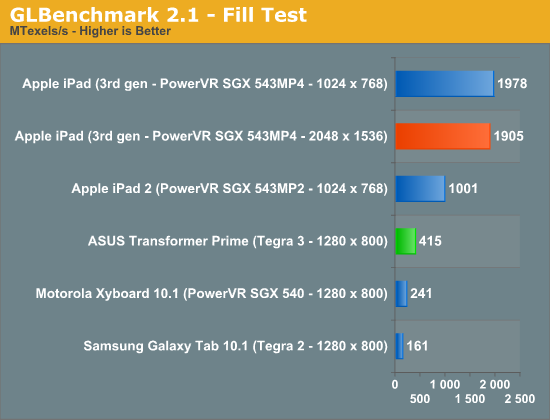
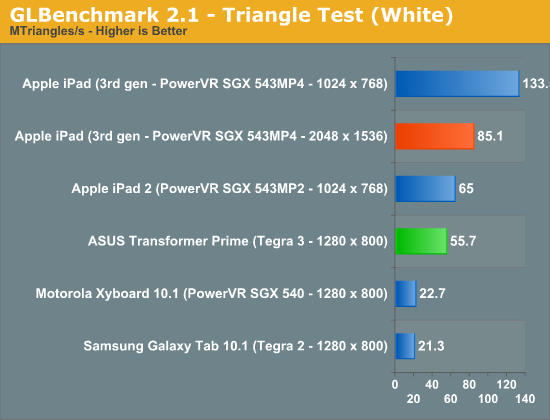
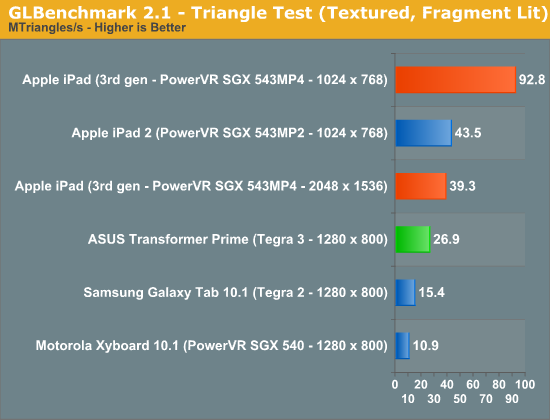
Indeed we see a roughly 2x increase in triangle and fill rates. Below we have the output from GLBenchmark's low level tests. Pay particular attention to how, at 1024 x 768, performance doubles compared to the iPad 2 but at 2048 x 1536 performance can drop to well below what the iPad 2 was able to deliver at 10 x 7. It's because of this drop in performance at the iPad's native resolution that we won't see many (if any at all), visually taxing games run at anywhere near 2048 x 1536.
| GLBenchmark 2.1.3 Low Level Comparison | ||||||
| iPad 2 (10x7) | iPad 3 (10x7) | iPad 3 (20x15) | ASUS TF Prime | |||
| Trigonometric test—vertex weighted |
35 fps
|
60 fps
|
57 fps
|
47 fps
|
||
| Trigonometric test—fragment weighted |
7 fps
|
14 fps
|
4 fps
|
20 fps
|
||
| Trigonometric test—balanced |
5 fps
|
10 fps
|
2 fps
|
9 fps
|
||
| Exponential test—vertex weighted |
59 fps
|
60 fps
|
60 fps
|
41 fps
|
||
| Exponential test—fragment weighted |
25 fps
|
49 fps
|
13 fps
|
18 fps
|
||
| Exponential test—balanced |
19 fps
|
37 fps
|
8 fps
|
7 fps
|
||
| Common test—vertex weighted |
49 fps
|
60 fps
|
60 fps
|
35 fps
|
||
| Common test—fragment weighted |
8 fps
|
16 fps
|
4 fps
|
28 fps
|
||
| Common test—balanced |
6 fps
|
13 fps
|
2 fps
|
12 fps
|
||
| Geometric test—vertex weighted |
57 fps
|
60 fps
|
60 fps
|
27 fps
|
||
| Geometric test—fragment weighted |
12 fps
|
24 fps
|
6 fps
|
20 fps
|
||
| Geometric test—balanced |
9 fps
|
18 fps
|
4 fps
|
9 fps
|
||
| For loop test—vertex weighted |
59 fps
|
60 fps
|
60 fps
|
28 fps
|
||
| For loop test—fragment weighted |
30 fps
|
57 fps
|
16 fps
|
42 fps
|
||
| For loop test—balanced |
22 fps
|
43 fps
|
11 fps
|
15 fps
|
||
| Branching test—vertex weighted |
58 fps
|
60 fps
|
60 fps
|
45 fps
|
||
| Branching test—fragment weighted |
58 fps
|
60 fps
|
30 fps
|
46 fps
|
||
| Branching test—balanced |
22 fps
|
43 fps
|
16 fps
|
16 fps
|
||
| Array test—uniform array access |
59 fps
|
60 fps
|
60 fps
|
60 fps
|
||
| Fill test—Texture Fetch |
1001483136 texels/s
|
1977874688
texels/s |
1904501632
texels/s |
415164192
texels/s |
||
| Triangle test—white |
65039568
triangles/s |
133523176
triangles/s |
85110008
triangles/s |
55729532
triangles/s |
||
| Triangle test—textured |
56129984
triangles/s |
116735856
triangles/s |
71362616
triangles/s |
54023840
triangles/s |
||
| Triangle test—textured, vertex lit |
45314484
triangles/s |
93638456
triangles/s |
46841924
triangles/s |
28916834
triangles/s |
||
| Triangle test—textured, fragment lit |
43527292
triangles/s |
92831152
triangles/s |
39277916
triangles/s |
26935792
triangles/s |
||
GLBenchmark also includes two tests designed to be representative of a workload you could see in an actual 3D game. The older Pro test uses OpenGL ES 1.0 while Egypt is an ES 2.0 test. These tests can either run at the device's native resolution with vsync enabled, or rendered offscreen at 1280 x 720 with vsync disabled. The latter offers us a way to compare GPUs without device screen resolution creating unfair advantages.
Unfortunately there was a bug in the iOS version of GLBenchmark 2.1.2 that resulted in all on-screen benchmarks running at 1024 x 768 rather than the new iPad's native 2048 x 1536 resolution. This is why all of the native GLBenchmark scores from the new iPad are capped at 60 fps. It's not because the new GPU is fast enough to render at speeds above 60 fps at 2048 x 1536, it's because the benchmark is actually showing performance at 1024 x 768. Luckily, GLBenchmark 2.1.3 fixes this problem and delivers results at the new iPad's native screen resolution:

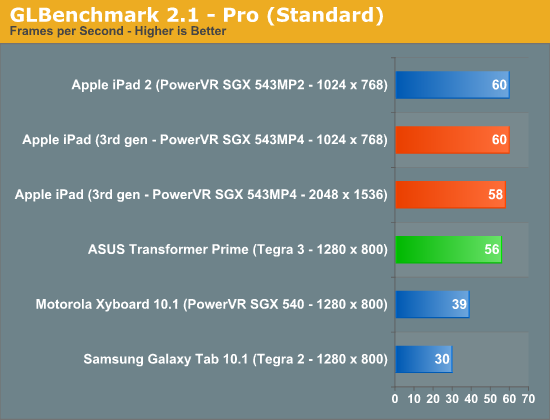
Surprisingly enough, the A5X is actually fast enough to complete these tests at over 50 fps. Perhaps this is more of an indication of how light the Egypt workload has become, as the current crop of Retina Display enhanced 3D titles for the iPad all render offscreen to a non-native resolution due to performance constraints. The bigger takeaway is that with the 543MP4 and a quad-channel LP-DDR2 interface, it is possible to run a 3D game at 2048 x 1536 and deliver playable frame rates. It won't be the prettiest game around, but it's definitely possible.
The offscreen results give us the competitive analysis that we've been looking for. With a ~2x die size advantage, the fact that we're seeing a 2-3x gap in performance here vs. NVIDIA's Tegra 3 isn't surprising:
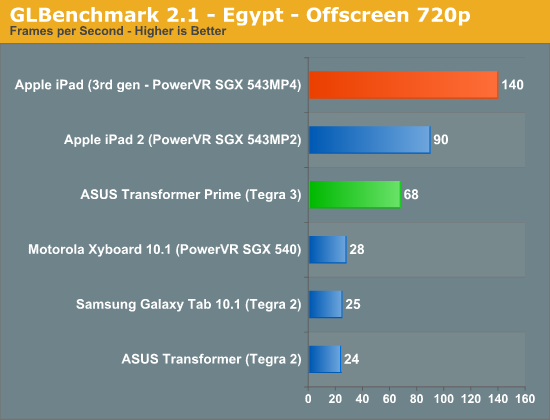
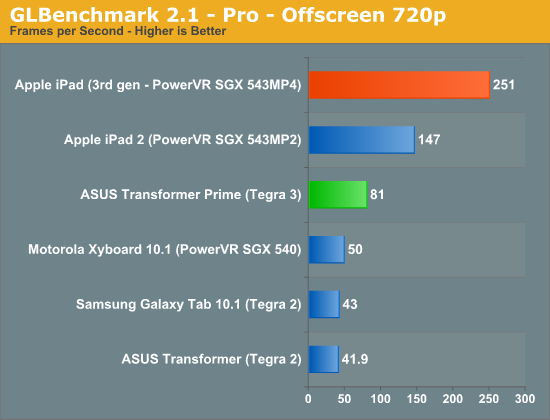
The bigger worry is what happens when the first 1920 x 1200 enabled Tegra 3 tablets start shipping. With (presumably) no additional GPU horsepower or memory bandwidth under the hood, we'll see this gap widen.










234 Comments
View All Comments
sciwizam - Wednesday, March 28, 2012 - link
Did the test suite change from your review of the Galaxy Tab 10.1 LTE?Anand Lal Shimpi - Wednesday, March 28, 2012 - link
It did indeed, let me see if I can't run the updated suite on the Galaxy Tab 10.1 LTE though...Take care,
Anand
jadawgis732 - Wednesday, March 28, 2012 - link
Hey Anand, I always wanted to say how much I admire your reviews, and how unbiased and untouched by corporate dollars they are. Keep up the great work! Also, it's very nice to see you responding to replies in the comments!Anand Lal Shimpi - Thursday, March 29, 2012 - link
Thank you for the kind words and for reading the site :)Take care,
Anand
medi01 - Thursday, March 29, 2012 - link
Samsung Galaxy Tab randomly dissapearing from charts where it would look favourably indeed leaves "unbiased" impression. (For instance color gamut is on par with "ipad 3" and way above ipad2)Anand Lal Shimpi - Friday, March 30, 2012 - link
I promise it's not that sinister :) I simply opted to compare to the best of the best out there today as far as Android tablets are concerned: the ASUS Transformer Prime.I understand the desire for more results so I'll be working on them in the background over the weekend.
Take care,
Anand
xytc - Wednesday, March 28, 2012 - link
I've heard that Apple's strong marketing campaign penetrates pussies, so if you have an Apple product you're nothing but a pussy. LMFAOPeteH - Wednesday, March 28, 2012 - link
Really?MobiusStrip - Thursday, March 29, 2012 - link
"LMFAO"?Wow, low humor threshold.
Wardawg - Thursday, April 5, 2012 - link
Well most people adept in technology or use tech in their buisness use apple products: djs programmers, and others, and frankly I see more iPhones being used than androids. So apparently most of the world is pussies by your definition. Please do research before you bash a company's products